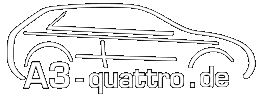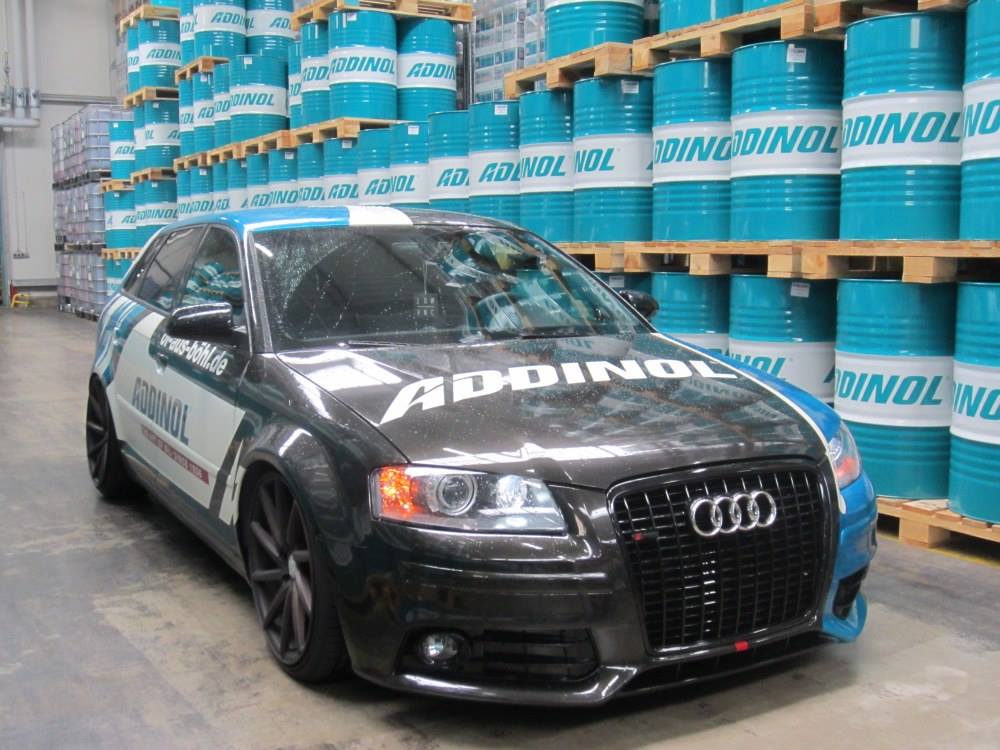Sie sind nicht angemeldet.
Benutzerinformationen überspringen
Registrierungsdatum: 16. Januar 2010
Aktuelles Auto: Golf 7 Sportsvan / VCDS
Benutzerinformationen überspringen
Anfänger
Registrierungsdatum: 18. November 2011
Aktuelles Auto: Audi A3 2.0 TFSI Quattro 8V
Postleitzahl: 97980
Wohnort: Bad Mergentheim
Hallo,
bin am Freitag beim Freundlichen meines Vertrauens (?!) gewesen und habe einen Mechaniker, der laut Meister wohl schon mal einen Wagen bez. Steuerkette bearbeitet hat, meinen Golf abhören lassen. Dieser meinte, wenn es eine gelängte Kette wäre, müsste ein Licht im Armaturenbrett angehen, da die Steuerzeiten nicht mehr stimmen würden. Auch würde das Geräusch viel lauter sein und dauerhaft hörbar sein. "Mein" Geräusch erscheint nur alle paar Sekunden und könnte seiner Meinung nach von einer Spannrolle des Keilriemens kommen. Wenn nicht, müsste man auf Geräuschsuche gehen. Ob ich mit dem Golf noch fahren könne, wollte er natürlich nicht verantworten...
Bin heute noch mal eine kurze Strecke gefahren, dabei hat er beim Anlassen in der Garage ein lautes metallisches schnarrendes Geräusch für einige Sekungen abgeben. Mittlerweile hört man bis ca. Tempo 80 das Laufgeräusch der Kette oder eben der Fehlerquelle, traue mich jetzt nicht mehr zu fahren. Aufgefallen ist mir auch, dass der Motor, der sonst (wenn er warm ist) im Leerlauf unhörbar, gut zu vernehmen ist. Auch bewegt sich die Maschine, hätte schwören können, dass man eine Münze auf die Abdeckung stellen können und diese wäre nicht umgefallen...
Befürchte mittlerweile, dass da so richtig was auf mich zukommt. Netterweise haben wir gerade gebaut und ein riesen Polster für Reparaturen...Werde, auch durch den Hinweis von GolfX sensibilisiert, zur Fehlerbehebung zum Freundlichen gehen.
Gruss
Chris
Benutzerinformationen überspringen
Registrierungsdatum: 16. Januar 2010
Aktuelles Auto: Golf 7 Sportsvan / VCDS
Na ja - aus Angst vor dem Tode brauchst Du noch nicht Selbstmord begehen - so sagt man doch?
Zitat
Bin trotzdem am Überlegen, den Golf im Frühjahr abzustoßen, da ich, wie
geschildert, zu lange mit dem Longlife-Öl herumkutschiert bin.
Dieser Beitrag wurde bereits 1 mal editiert, zuletzt von »golfx« (29. November 2011, 13:32)
Benutzerinformationen überspringen
Registrierungsdatum: 19. September 2011
Postleitzahl: 30449
Wohnort: Hannover
Benutzerinformationen überspringen
Registrierungsdatum: 16. Januar 2010
Aktuelles Auto: Golf 7 Sportsvan / VCDS

Benutzer, die sich für diesen Beitrag bedankt haben:
Pende (07.12.2011)
Benutzerinformationen überspringen
Registrierungsdatum: 11. Januar 2009
Aktuelles Auto: Audi A4 Allroad 50 TDI (ehemals. A3 3.2 Quattro DSG - S-Line)
Postleitzahl: 96450
Wohnort: Coburg
Weil wir gerade beim Thema sind:
http://www.motor-talk.de/forum/3-zylinde…l-t3167719.html
Besonders Bild 4.
Da zieht`s einem die Schuhe aus ...


 ... Zahnflanken schön an der Bandschleifmaschine runtergeschliffen?
... Zahnflanken schön an der Bandschleifmaschine runtergeschliffen? 


Benutzerinformationen überspringen
Registrierungsdatum: 16. Januar 2010
Aktuelles Auto: Golf 7 Sportsvan / VCDS

Benutzerinformationen überspringen
Registrierungsdatum: 11. Juni 2011
Aktuelles Auto: Skoda Yeti TDI und Roomster TSI
Postleitzahl: 373xx
Benutzerinformationen überspringen
Registrierungsdatum: 21. Mai 2004
Aktuelles Auto: Audi A3 3.2
Postleitzahl: 67459
Wohnort: Böhl-Iggelheim



Benutzerinformationen überspringen
Anfänger
Registrierungsdatum: 27. April 2011
Aktuelles Auto: VW Golf VI TSI
Postleitzahl: 46049
Benutzerinformationen überspringen
Registrierungsdatum: 21. Mai 2004
Aktuelles Auto: Audi A3 3.2
Postleitzahl: 67459
Wohnort: Böhl-Iggelheim




Benutzerinformationen überspringen
Registrierungsdatum: 11. Juni 2011
Aktuelles Auto: Skoda Yeti TDI und Roomster TSI
Postleitzahl: 373xx
Benutzerinformationen überspringen
Registrierungsdatum: 16. Januar 2010
Aktuelles Auto: Golf 7 Sportsvan / VCDS
Benutzerinformationen überspringen
Registrierungsdatum: 11. Juni 2011
Aktuelles Auto: Skoda Yeti TDI und Roomster TSI
Postleitzahl: 373xx


 ) falls es doch noch Probleme geben sollte, man weiß ja nie.
) falls es doch noch Probleme geben sollte, man weiß ja nie.
 vor der ganzen Arbeit die ihr schon in das Thema gesteckt habt
vor der ganzen Arbeit die ihr schon in das Thema gesteckt habt Benutzerinformationen überspringen
Registrierungsdatum: 16. Januar 2010
Aktuelles Auto: Golf 7 Sportsvan / VCDS
Dieser Beitrag wurde bereits 5 mal editiert, zuletzt von »golfx« (28. December 2011, 09:11)
Benutzerinformationen überspringen
Registrierungsdatum: 11. Juni 2011
Aktuelles Auto: Skoda Yeti TDI und Roomster TSI
Postleitzahl: 373xx
Benutzerinformationen überspringen
Registrierungsdatum: 21. Mai 2004
Aktuelles Auto: Audi A3 3.2
Postleitzahl: 67459
Wohnort: Böhl-Iggelheim

Zitat
1.4 TSI temporarily deactivates two cylinders in low to mid load conditions
World’s first implementation in four cylinder TSI engines
Volkswagen continues to make great strides in improving the fuel economy of its vehicle models. The latest efficiency technology is cylinder shut-off – it will debut in the new 1.4 TSI in early 2012.
Groundbreaking innovation.
The high-tech system temporarily deactivates two of the four cylinders under low to mid load situations. In the EU driving cycle, this saves 0.4 liters of petrol per 100 km. Fuel savings may increase to over 1 liter under certain driving situations. Cylinder shut-off is a groundbreaking innovation – Volkswagen is the first carmaker to implement this technology in a turbocharged four-cylinder engine in large-scale production.
Very smooth running
Drivers are only informed of the two-cylinder status if they select momentary fuel economy in the multifunction display. Otherwise, they would hardly notice the change. Even when running on just two cylinders, the 1.4 TSI – with its excellent engine balance – is still very quiet and low in vibration.
Broad characteristic map
Cylinder shut-off is active whenever the 1.4 TSI’s engine speed lies between 1,400 and 4,000 rpm and its torque lies between 25 and 75 Nm. This applies to nearly 70 per cent of the driving distance in the EU fuel economy driving cycle. First, the combustion chambers are filled with air – this entrapped fresh air leads to minimal cylinder pressure and therefore to lower energy consumption. Afterwards, the system closes the intake and exhaust valves of cylinders 2 and 3; engine ignition only occurs once per crankshaft revolution. The pistons of the deactivated cylinder are now dragged by the crankshaft. On the other hand, efficiency increases in the two active cylinders, because their operating points are shifted to higher loads.
Complex technology
The valves are closed using a complex set of actuators: on both the intake camshaft and the exhaust camshaft, there are two adjustable sleeves known as cam pieces that are placed on special tooth systems. They are responsible for the eight valves of the second and third cylinders. At the ends of each cam piece, there are two different profiles adjacent to one another – a conventional full profile and a so-called zero lift cam. The full profiles actuate the roller cam followers, which in turn actuate the valves in four-cylinder operation; that is, they behave like very conventional cams. However, the zero lift cams rotate over the followers – i.e. they do not actuate them –, and the valve springs hold the valves shut. Engine management simultaneously shuts off fuel injection.
Spiral-shaped slots are milled in the outer surfaces of the rotating cam pieces; these slots permit shifting the sleeves a few millimeters along the shafts at lightning speed; when electromagnetic actuators in the valve cover get a signal from the engine controller, two integrated metal pins engage the slots from outside and move them to their end positions. Finally, the cam pieces are locked in place by spring-loaded balls. As soon as the driver presses the accelerator pedal sufficiently, cylinders 2 and 3 are reactivated.
All mechanical switchover processes are executed within one-half camshaft revolution; they last between 13 and 36 milliseconds, depending on engine speed. These processes are smoothed by accompanying interventions in ignition and throttle valve control.
Volkswagen utilizes information from the accelerator pedal sensor to detect the driver’s momentary style of driving. If the driving exhibits a nonuniform pattern – e.g. while driving in roundabout traffic or using a sporty gear-shifting style on a country road – the shut-off functionality is suppressed.
Altogether, the components for cylinder shut-off weigh a total of just over 3 kilograms. Their actuators, the camshafts and their bearing carriers are integrated in the valve cover. Two roller bearings reduce the friction of the shafts.
Potential for nearly 1 liter less fuel consumption
In the NEDC driving cycle, cylinder shut-off reduces the 1.4 TSI’s fuel consumption by 0.4 liter per 100 km – a CO2 equivalent of 8 grams per km. If the Stop/Start system is also considered, which deactivates the engine in neutral gear, savings total about 0.6 liters per 100 km. The greatest benefits of the new technology are realized while driving at constant moderate speeds. At 50 km/h, in third or fourth gear, savings amount to nearly one liter per 100 km. At 70 km/h in fifth gear, for example, fuel consumption is still reduced by 0.7 liters per 100 km.
The new 1.4 TSI, pressurized by a turbocharger, outputs 103 kW (140 PS) here. Between 1,500 and 4,000 rpm it transfers a powerful 250 Nm of torque to the crankshaft under load.
Volkswagen is currently the first carmaker to implement cylinder shut-off in a mass produced four-cylinder TSI engine.
The TSI combustion method – petrol direct injection plus turbocharging – is actually essential in implementing cylinder shut-off technology in its current form. That is because it eliminates complications in gas exchange that would otherwise occur in multi-point injection engines. This new TSI will also be able to fulfill the future EU6 emissions standard.
Volkswagen will be introducing cylinder shut-off on Volkswagen production cars in early 2012.
Note:
Features and technical data apply to models offered in Germany. They may differ in other countries. All fuel economy and driving performance data are forecast values as of August 2011.



Benutzerinformationen überspringen
Registrierungsdatum: 16. Januar 2010
Aktuelles Auto: Golf 7 Sportsvan / VCDS
Dieser Beitrag wurde bereits 1 mal editiert, zuletzt von »golfx« (8. January 2012, 17:17)
Benutzerinformationen überspringen
Registrierungsdatum: 21. Mai 2004
Aktuelles Auto: Audi A3 3.2
Postleitzahl: 67459
Wohnort: Böhl-Iggelheim




3 Besucher
Unsere Website verwendet sogenannte Cookies. Dabei handelt es sich um kleine Textdateien, die mit Hilfe des Browsers auf Ihrem Endgerät abgelegt werden. Wir nutzen Cookies dazu, unser Angebot nutzerfreundlich zu gestalten. Einige Cookies bleiben auf Ihrem Endgerät gespeichert bis Sie diese löschen. Cookies ermöglichen es uns, Ihren Browser beim nächsten Besuch wiederzuerkennen. Wenn Sie dies nicht wünschen, so können Sie Ihren Browser so einrichten, dass er Sie über das Setzen von Cookies informiert und Sie dies nur im Einzelfall erlauben. Bei der Deaktivierung von Cookies kann die Funktionalität unserer Website eingeschränkt sein.
Durch schließen dieser Meldung akzeptieren sie das speichern von Cookies auf Ihrem Gerät.
Hits heute: 203 800 | Hits gestern: 532 639 | Hits Tagesrekord: 880 406 | Hits gesamt: 503 921 889 | Klicks heute: 249 511 | Klicks Tagesrekord: 1 264 787

